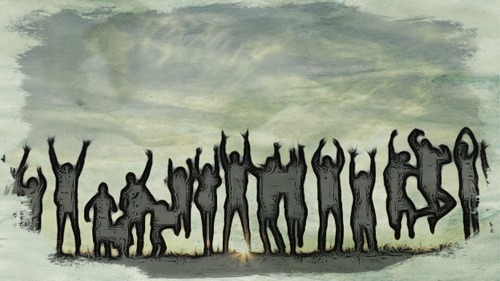
CHRONICLES OF THE DOKA
Part 9 in a continuing series
Bang! The long awaited explosion happened. Mankind set out in a din and roar of dust, whoopees and ravenous desires. Their cries faded in the distance until the tinkerer could barely make out their small dust cloud on the horizon. He’d been left behind. Yet, he had this odd unshakable faith. He believed that when he finished the construction of his vehicle it would have such thrust and propulsion that it would surely catch up to the others. At the very least, he felt that he could finally cast off his solitary pursuits and join his brothers and sisters in the search of earthly security and success.
But something unexpected and far stranger occurred. The tinkerer fell into a thirty year long, Rip Van Winkle, reverie toying with his machine. That starting riposte, which seemed like it had been fired only seconds ago, had actually fired an ungodly, three decades earlier. It was as if time, like a heart, had simply slipped into a suspended animation. He thought there was still a chance to join everyone when, in fact, mankind had been fully engaged in their pursuits; having babies, making careers, exploring outer space, getting divorced, watching TV, and eating strawberry cheesecake.
The tinkerer stood up and peered into the horizon, momentarily distracted from his tinkering. He eyed an approaching dust storm. “Hadn’t the gun just fired,” he thought? Time felt backward. Instead of moving away form him, the dusty mirage appeared to be moving toward him. Faint images came into view. Waves of hobbling battered and beaten human refugees, carrying others too ill to walk, were heading back toward the starting line. It was as if they had been in some great conflagration, some unavoidable, horrid war. The previously wealthy arrived without riches, unadorned, their clothes tattered and torn. Of course, not everyone fared poorly. Some returned in expensive SUV’s. But their hearts were gaunt with hallow expressions of despair, fatigue, and disgust. It quickly became apparent to him that something was missing. Whatever they had been looking for wasn’t to be found ‘out there.’
. . . . .
Those of you reading this story know that the people who return to the starting gate are the disenchanted victims of the illusion that the heart of life is found solely in the hills, meadows, and valleys of the world, that is, on the ‘outskirts’ of life, so to speak, in the external world, or by taking the little blue pill of happiness.
As the refugees set up base camps, some wandered over to the now, middle-aged tinker. He was the only oasis in sight on the barren plain. They circled around his strange vehicle.
“How did he survive?” people were curious. “He doesn’t seem to have aged.”
Their murmurs and whispers drew him out of his introspective state. He saw famished souls hungrily eying his vehicle as a hope for reclaiming their lost dreams. He turned to look at his vehicle and for the first time he actually saw what they were eying. His prison was their oasis, a sanctuary, a spiritual haven, a renewed hope. The tinkerer finally understood that after all the years he had spent toiling on what others scoffed as a useless and trivial undertaking, he had completed a sleek fantastic, spiritual vehicle— light, fast, colorful, but above all, authentic. It was attuned and tuned in.
It was then that he took the key that was his will. He switched on the battery of his heart, charging and affirming it by their faces, and finally knew that the vehicle he had been constructing all this time was his own authentic self.
The multitude was inspired. “How can we build such a vehicle? “ They asked him.
“I could teach you,” he said.
To honor this particular tinkerer, they called him sensei. To their yang he was their missing yin. To their martial wound he was their spiritual salve. All of life is complimentary. For every receiver there is giver. For every need there is a fulfillment. Desire manifests its own satiety. Whether the sensei finds his students or the students find their sensei there is union. The solitary worker becomes the community spirit. The unfinished, unopened, and fragmented set to work to complete, to reveal, and to unify. Their work had begun. That day the dojo was created and they all set to tinkering on their own vehicles. They removed their worn clothing and tied cloth belts around virgin white robes and started over again. They began first by reconstructing the frame with a careful examination of their nature, and of their deepest conflicts and desires.
